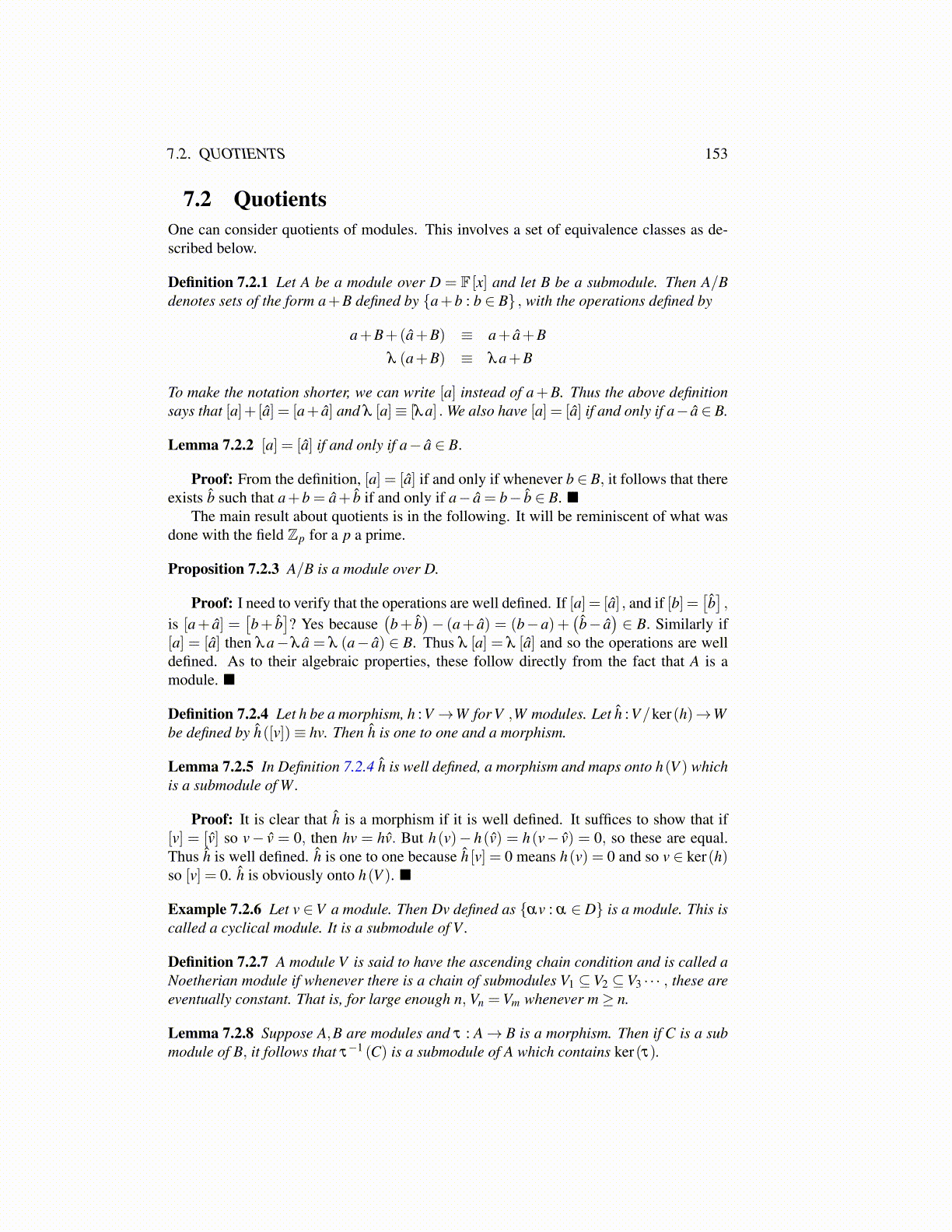
7.2. QUOTIENTS 153
7.2 QuotientsOne can consider quotients of modules. This involves a set of equivalence classes as de-scribed below.
Definition 7.2.1 Let A be a module over D = F [x] and let B be a submodule. Then A/Bdenotes sets of the form a+B defined by {a+b : b ∈ B} , with the operations defined by
a+B+(â+B) ≡ a+ â+B
λ (a+B) ≡ λa+B
To make the notation shorter, we can write [a] instead of a+B. Thus the above definitionsays that [a]+[â] = [a+ â] and λ [a]≡ [λa] . We also have [a] = [â] if and only if a− â ∈ B.
Lemma 7.2.2 [a] = [â] if and only if a− â ∈ B.
Proof: From the definition, [a] = [â] if and only if whenever b ∈ B, it follows that thereexists b̂ such that a+b = â+ b̂ if and only if a− â = b− b̂ ∈ B. ■
The main result about quotients is in the following. It will be reminiscent of what wasdone with the field Zp for a p a prime.
Proposition 7.2.3 A/B is a module over D.
Proof: I need to verify that the operations are well defined. If [a] = [â] , and if [b] =[b̂],
is [a+ â] =[b+ b̂
]? Yes because
(b+ b̂
)− (a+ â) = (b−a)+
(b̂− â
)∈ B. Similarly if
[a] = [â] then λa−λ â = λ (a− â) ∈ B. Thus λ [a] = λ [â] and so the operations are welldefined. As to their algebraic properties, these follow directly from the fact that A is amodule. ■
Definition 7.2.4 Let h be a morphism, h :V →W for V ,W modules. Let ĥ :V/ker(h)→Wbe defined by ĥ([v])≡ hv. Then ĥ is one to one and a morphism.
Lemma 7.2.5 In Definition 7.2.4 ĥ is well defined, a morphism and maps onto h(V ) whichis a submodule of W.
Proof: It is clear that ĥ is a morphism if it is well defined. It suffices to show that if[v] = [v̂] so v− v̂ = 0, then hv = hv̂. But h(v)− h(v̂) = h(v− v̂) = 0, so these are equal.Thus ĥ is well defined. ĥ is one to one because ĥ [v] = 0 means h(v) = 0 and so v ∈ ker(h)so [v] = 0. ĥ is obviously onto h(V ). ■
Example 7.2.6 Let v ∈V a module. Then Dv defined as {αv : α ∈ D} is a module. This iscalled a cyclical module. It is a submodule of V .
Definition 7.2.7 A module V is said to have the ascending chain condition and is called aNoetherian module if whenever there is a chain of submodules V1 ⊆V2 ⊆V3 · · · , these areeventually constant. That is, for large enough n, Vn =Vm whenever m≥ n.
Lemma 7.2.8 Suppose A,B are modules and τ : A→ B is a morphism. Then if C is a submodule of B, it follows that τ−1 (C) is a submodule of A which contains ker(τ).